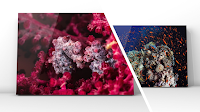The Angkor temples, located in Cambodia, are some of the most breathtaking architectural wonders of the world. These ancient ruins, built between the 9th and 15th centuries, have captured the hearts of many with their intricate designs and rich history. Now, a new way to appreciate the beauty of these temples has emerged: a mosaic of 12 black and white photographs.
The black and white aesthetic gives these photographs a unique, yet authentic impression of the ambiance of the ancient temple ruins. By stripping away the color, the focus is solely on the details and patterns of the temple's architecture. The intricate carvings, doorways, and archways are highlighted in a way that is both striking and mesmerizing. The black and white palette also adds a touch of sophistication, making the mosaic a versatile piece of wall art that will complement any decor style.
Each of the 12 photographs was carefully selected to showcase different aspects of the Angkor temples. From the towering spires of Angkor Wat to the intricate carvings at Bayon Temple, each photograph offers a glimpse into the rich history and breathtaking beauty of these ancient ruins. The photographs are arranged in a mosaic pattern, with each image seamlessly blending into the next. The result is a cohesive and visually stunning piece of art that is sure to captivate anyone who sees it.
Whether you're an art lover, history buff, or simply someone who appreciates beauty, this mosaic is sure to impress. Its versatility and unique style make it a perfect addition to any home or office space. Whether it's displayed in a living room, bedroom, or office, this mosaic is sure to become a conversation piece that will draw admiration from all who see it.
In conclusion, the mosaic of 12 black and white photographs of Angkor temples is a must-have for anyone looking to add a touch of elegance and sophistication to their home or office decor. The black and white aesthetic adds a unique and timeless quality to these already stunning photographs, and the mosaic pattern showcases the beauty of these ancient ruins in a way that is both visually stunning and captivating. So why wait? Get your own mosaic of Angkor temples today and experience the beauty for yourself!














